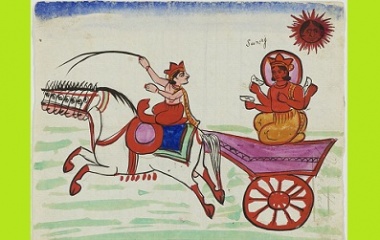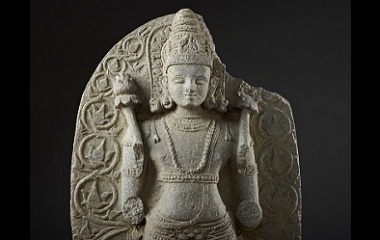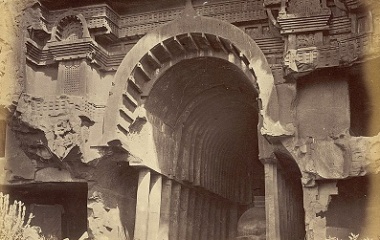- Pronunciation: suur–yaa
- Origin: India
- Role: Sun god
- Wives: Sharanya, Ragyi, Prabha
Who Is Surya?
Surya is both the god of the sun, and the sun itself. A high ranking deity, especially in the earlier Hindu Scriptures, notably the Vedas, which date as far back as 1500 B.C., he is worshipped as the supreme god by the small Saura sect. He is, however, also recognized by most Hindus, who say a special mantra called the Gayatri mantra at the dawn of the day to Surya.
Surya is the supreme source of energy and light and the origin of the universe. He controls the seasons so he was of particular importance to the agricultural community. He is also a healer god, and considered to bring good luck. Many shops in India have a symbol of the sun on or near their front door.
In later scripture, Surya, also known by the name Savita, lost some of his prominence to Vishnu. Although his image appears in many temples, there are just a few dedicated specifically to him. The most famous is the temple of the sun in Orissa, India.
Origin
Surya is an early deity in the Hindu creation myth. He was written about in the Rig Veda, the oldest of the texts. When the universe was created, the egg of the world split into two parts. The silver half became the earth and the gold half became the sky. The parts inside of the egg became the mountains, the clouds and the waters. Lord Brahma emerged from the cosmic egg and created the supreme god Vishnu. The very first sound in the cosmos, Om, united with the intelligence of Vishnu and Surya was created.
He is depicted most often riding in a chariot drawn by seven horses with his charioteer, Aruna, the god of dawn. The seven horses represent the seven chakras (spiritual centers) in the human body and the seven colors in a rainbow. Surya has either two hands, each holding a lotus flower to symbolize rebirth, or four hands that hold a conch shell, a disc representing the chakras, a lotus and a mace (ancient weapon).
Gayatri Mantra
The Gayatri Mantra dedicated to Surya is considered one of the most powerful mantras in the Hindu religion. It is believed that the order and choice of words is arranged specifically to create an energetic power that impacts the person who chants in their body, their mind and spiritual self. The mantra is the very essence of the Vedas. It begins with the sound of Om, the very first sound that ever existed. Om is also a metaphor for divine energy and the oneness of all beings or a supreme being.
Om Bhur Bhuvaḥ Swaḥ
Tat-savitur Vareñyaṃ
Bhargo Devasya Dhīmahi
Dhiyo Yonaḥ Prachodayāt
The general meaning of the ancient Sanskrit chant:
We mediate on the Supreme Lord and creator whose divine light illuminates all, the realm of the physical, mental and spiritual. May this divine light open our hearts and inspire our intellect.
Family of Surya
According to legend, Surya had three wives: Saranyu, the goddess of the clouds, Ragyi and Prabha. Saranyu was the mother of Manu, and the twin gods Yama (the god of death) and his sister Yami (the mother goddess). Later, she also gave birth to the Ashvin twins, the divine horsemen that symbolize the sunrise and sunset.
After their marriage, Saranyu couldn’t bear the intense light and heat of the midday sun so she created a shadow of herself called Chhaya to step in to act as Surya’s wife. Chhaya, the shadow wife, had two sons and two daughters, apparently before Surya figured out what was going on. Saranyu hid in the forest and transformed herself into a mare to keep Surya from recognizing her, but the god turned himself into a horse and went after her and they eventually reunited. Still suffering from his radiance, she was chronically exhausted. Finally, with the help of her father they toned down Surya’s brightness by one eighth and Saranyu was able to live more easily with her husband. The second wife, Ragyi, gave birth to a son named Revanta. Prabha had a son named Prabhata, which means morning.
Other Tales of Surya
In other Hindu texts, the Ramayana and the Mahabharata, there are also tales of Surya. When he was a baby, Hanuman, the supernatural monkey, stretched up to grab the sun because he thought it was a tasty mango. He put Surya in his mouth and the world went dark. The gods knew something was wrong so Lord Indra, the god of lightening, sent a bolt straight at Hanuman’s jaw and he dropped the sun.
Because he was always misbehaving, Hamuman was temporarily stripped of his magical powers, namely his ability to fly and transform himself. When he grew up, he needed a teacher and appealed to Surya to take him under his wing. Forgiving him for the incident from his childhood, Surya reminded him of his gifts, and taught Hanuman to lead the Army of Monkeys. Hamuman took all his lessons facing his teacher while his chariot rode swiftly across the sky, so he was always going backwards so as to not rudely turn his back on his guru. Hanuman and his monkey army eventually help Rama (a reincarnation of the god Vishnu) to save his wife from a demon.
In another myth of Surya, Kunti, the aunt of Lord Krishna, received a special mantra from a sage. Chanting the mantra would have allowed her to summon a god and bear his child. She didn’t take the mantra too seriously and, not believing it would actually work, she tested it out by summoning Surya. Forced to fulfill the powerful mantra, Surya came to her, and she had a son from Surya but still remained a virgin. Unable to deal with the idea of being an unwed mother, she abandoned her child. Karna later grew up to be a great warrior in the mythological Kurukshetra War.
Historical Influence
The practice of yoga also originated in the Vedas thousands of years ago. Known for its physical, mental, and spiritual benefits, yoga has millions of devotees in the Western world as well as in the East. The basis of yoga practice begins with the salute to the sun, surya namaskar.
It has been said that the sun salutations are the movements of Hanuman facing Surya as the chariot traveled across the sky, showing his gratitude for the lessons he learned, honoring Surya as the source of energy and light for the world.
Every day the world over, students stand facing their teacher as they perform their surya namaskar series with love and devotion in a show of respect for the tradition of honoring a teacher and the great Surya, who illuminates our lives and the universe.










